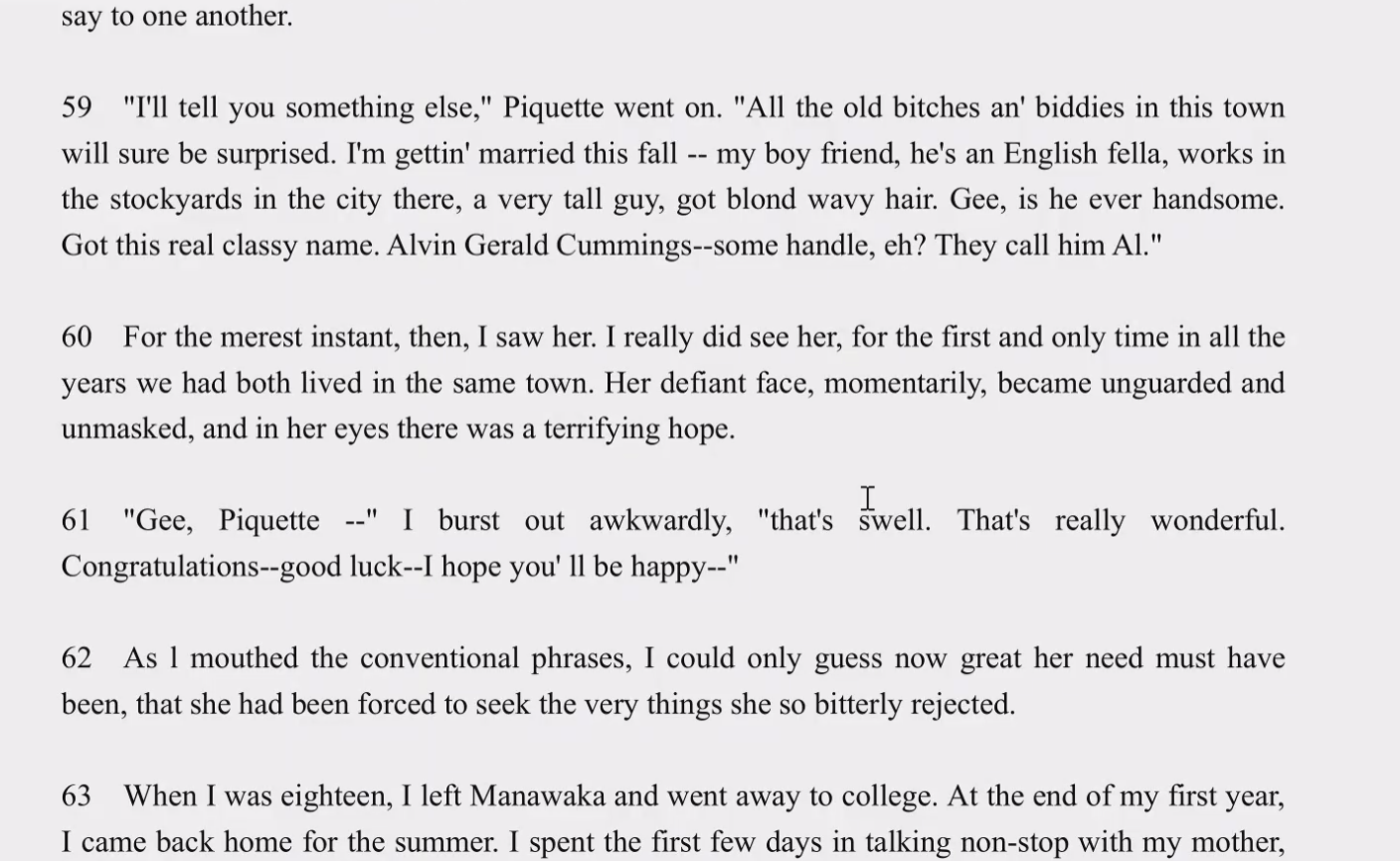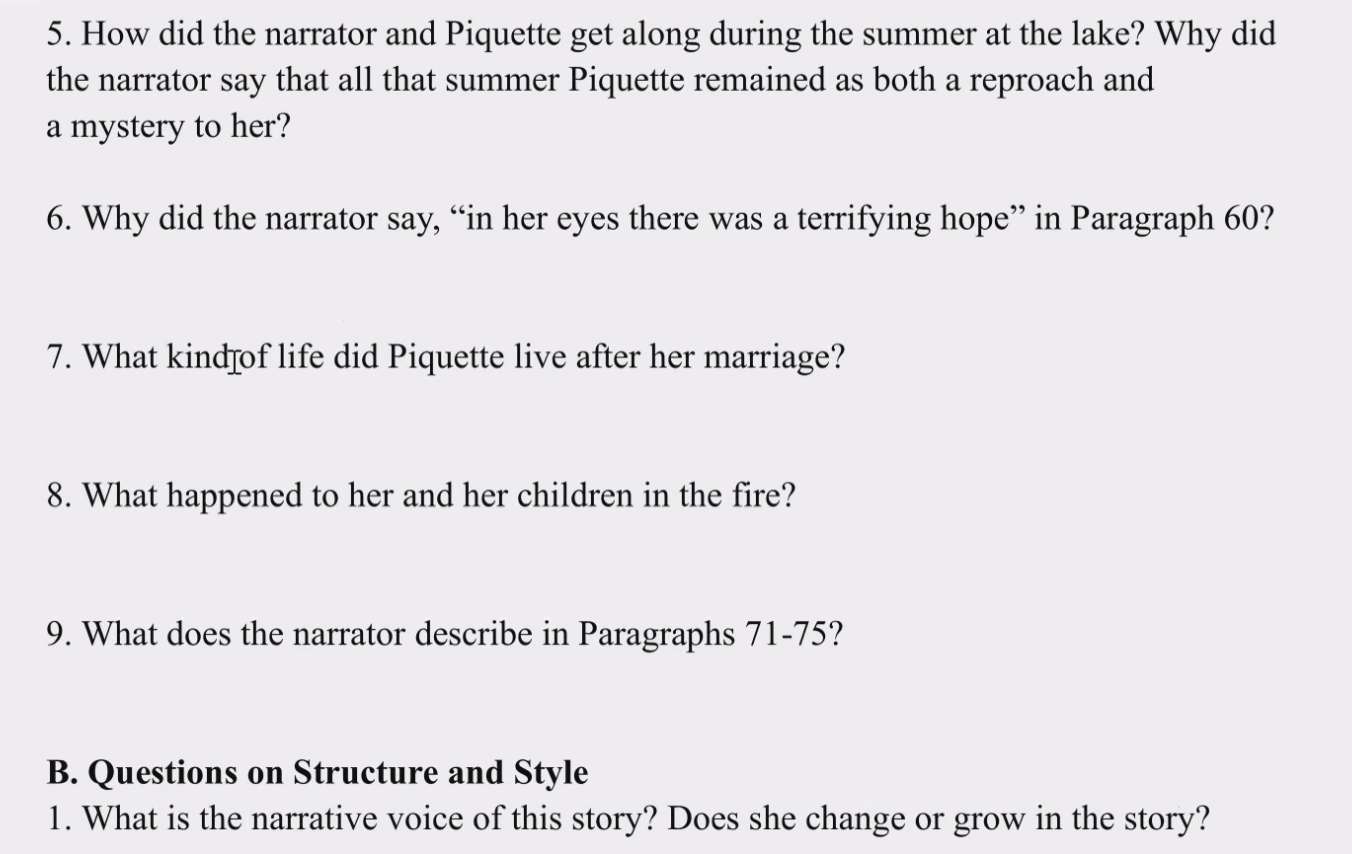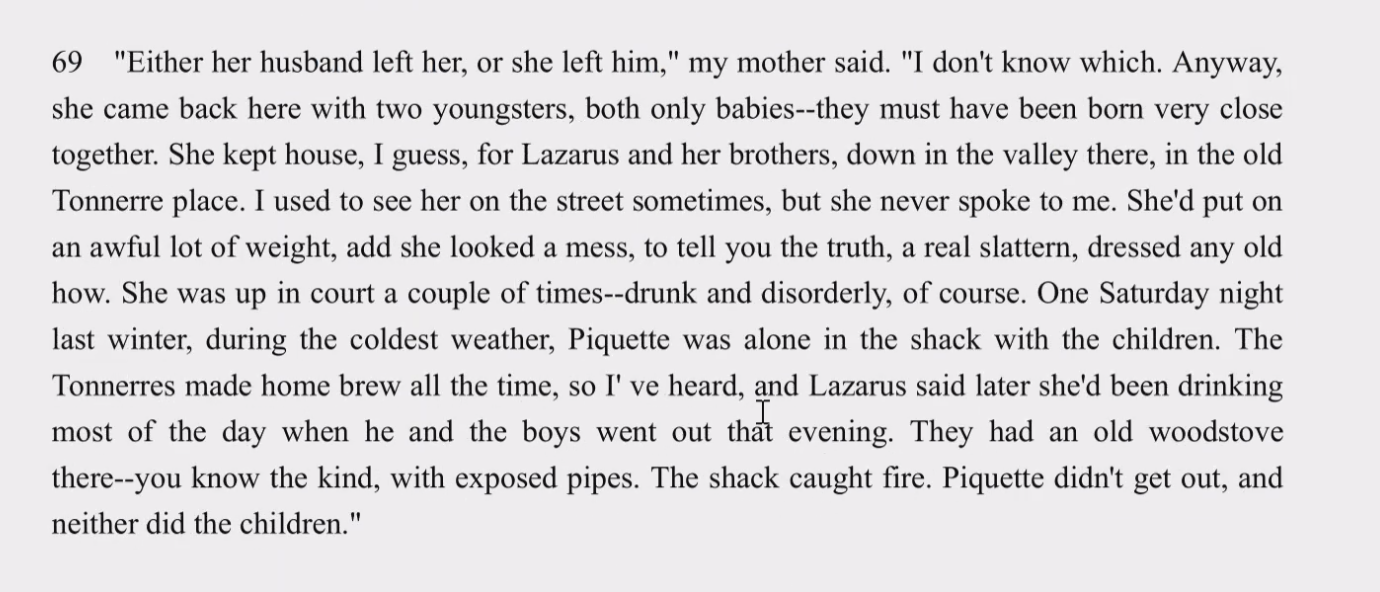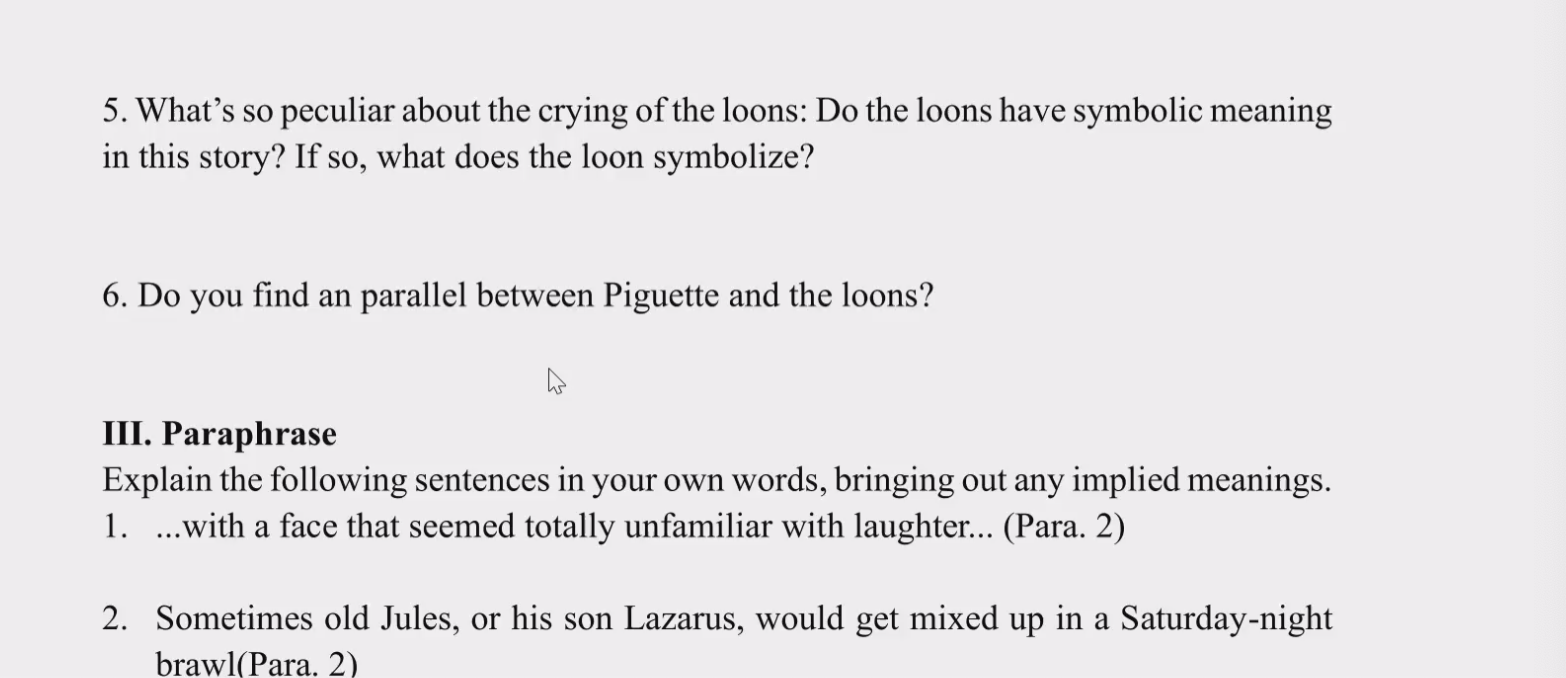5-30a
1å

but I did not know what was the matter, nor why she would not on could not respond when lsuggested exploring the woods or playing house. I thought it was probably her slow and difficultwalking that held her back. She stayed most of the time in the cottage with my mother, helping herwith the dishes or with Roddie, but hardly ever talking. Then the Duncans arrived at their cottage,and I spent my days with Mavis, who was my best friend. I could not reach Piquette at all, and l

say to one another.
59"I'll tell you something else," Piquette went on. "All the old bitches an' biddies in this townwill sure be surprised. I'm gettin' married this fall -- my boy friend, he's an English fella, works inthe stockyards in the city there, a very tall guy, got blond wavy hair. Gee, is he ever handsome.Got this real classy name. Alvin Gerald Cummings--some handle, eh? They call him Al."
60For the merest instant, then, I saw her, I really did see her, for the first and only time in all theyears we had both lived in the same town. Her defiant face, momentarily, became unguarded andunmasked, and in her eyes there was a terrifying hope.
61 "Gee, Piquette ." I burst out awkwardly, "that's swell. That's really wonderfulCongratulations--good luck--I hope you' ll be happy-."
62As I mouthed the conventional phrases, I could only guess now great her need must havebeen, that she had been forced to seek the very things she so bitterly rejected.
63When I was eighteen, I left Manawaka and went away to college. At the end of my first year.
I came back home for the summer. I spent the first few days in talking non-stop with my mother.

5. How did the narrator and Piquette get along during the summer at the lake? Why didthe narrator say that all that summer Piquette remained as both a reproach anda mystery to her?
6. Why did the narrator say, “in her eyes there was a terrifying hope in Paragraph 60?
7. What kindrof life did Piquette live after her marriage?
8. What happened to her and her children in the fire?
9. What does the narrator describe in Paragraphs 71-75?
B. Ouestions on Structure and Style1. What is the narrative voice of this story? Does she change or grow in the story?

B. Ouestions on Structure and Style
1. What is the narrative voice of this story? Does she change or grow in the story?
2. What is the story about? What is the theme of the story?
3 Who is the central character of the story?
1
这些问题是针对一个故事的结构和风格提出的,下面是对每个问题的基本翻译和解释:
1. **What is the narrative voice of this story? Does she change or grow in the story?**
- 翻译:这个故事的叙述声音是什么?她在故事中有所改变或成长吗?
- 解释:这个问题询问的是故事的叙述者(或叙述声音)的特性,比如是第一人称还是第三人称,是儿童视角还是成人视角,是男性还是女性等。此外,询问叙述者是否在故事中经历了变化或成长,这涉及到叙述者的内心世界和观点如何随着故事进展而发展。
2. **What is the story about? What is the theme of the story?**
- 翻译:这个故事是关于什么的?故事的主题是什么?
- 解释:这个问题要求概述故事的主要内容或情节,并识别故事想要传达的核心信息或主题。主题是故事试图探讨的中心概念或思想,比如爱、勇气、牺牲、成长等。
3. **Who is the central character of the story?**
- 翻译:谁是故事的中心人物?
- 解释:这个问题询问的是故事中的主要角色或主角。中心人物是推动故事发展和情节展开的关键角色,他们的经历和决策通常构成了故事的主线。
请注意,要提供具体的答案,需要阅读和分析具体的故事文本。上述解释仅适用于这些问题的一般性质。如果需要针对特定故事的详细答案,请提供故事的文本或更多信息。
1
http://livinginthelibraryworld.blogspot.com/2012/12/the-loons.html read the story the loons. and answer the questions; What is the story about? What is the theme of the story?**
1
**What is the story about?**
The story "The Loons" by Margaret Laurence, as presented in the provided text, is a narrative that centers around the life of the Tonnerre family, who are French half-breeds living in a shack below Manawaka. The family is marginalized and doesn't quite fit in with the Cree or the other settlers in the area. The protagonist, Vanessa, is a young girl who becomes aware of Piquette Tonnerre, a girl in her school who is part of the Tonnerre family and has a history of illness and poverty.
The story unfolds as Vanessa's father, a doctor, suggests that Piquette join their family for a summer at Diamond Lake to help her recover from her illness. This decision leads to a series of interactions and reflections on Vanessa's part, as she tries to connect with Piquette, who is initially distant and unresponsive. Vanessa's perception of Piquette is influenced by her romanticized notions of Native culture, which she associates with Piquette due to her heritage.
The narrative also touches on the themes of social alienation, the struggle for belonging, and the complexities of human relationships. It explores Vanessa's childhood innocence, her attempts to understand Piquette, and the tragic circumstances of Piquette's life.
**What is the theme of the story?**
The theme of "The Loons" is multifaceted, encompassing elements such as:
1. **Social Alienation and Marginalization**: The Tonnerre family, and particularly Piquette, are depicted as being on the fringes of society, neither fitting in with the Cree community nor the settlers.
2. **The Search for Belonging**: Piquette's struggle with her identity and place in the world is a central theme. Vanessa's attempts to connect with Piquette also reflect a desire for understanding and connection.
3. **The Innocence and Naivety of Childhood**: Vanessa's perspective is that of a child trying to make sense of the world and the people around her, particularly Piquette.
4. **The Impact of Poverty and Illness**: The story highlights the harsh realities of Piquette's life, shaped by poverty and her battle with tuberculosis.
5. **Nature and Its Symbolism**: The loons on the lake serve as a symbol of a world untouched by human strife, a world that is gradually being lost as development encroaches on the natural landscape.
6. **The Passage of Time and Change**: The story reflects on the changes that occur over time, both in the physical environment and in the lives of the characters.
7. **Empathy and Understanding**: Vanessa's struggle to understand Piquette and her eventual realization of the depth of Piquette's struggles highlight the theme of seeking empathy and understanding for those who are different from us.
8. **Loss and Memory**: The narrative concludes with Vanessa's memories of Piquette and the changes that have occurred since her childhood, reflecting on loss and the persistence of memory.
The story uses the character of Piquette and her interactions with Vanessa to explore these themes, providing a poignant look at the human condition and the complexities of life in a small community.

B. Ouestions on Structure and Style
# wenda 问答 P110 B
1. What is the narrative voice of this story? Does she change or grow in the story?
The narrative voice of "The Loons" is that of the protagonist, Vanessa, who tells the story in the first person. This perspective allows the reader to experience the story through Vanessa's eyes and understand her thoughts, feelings, and experiences as she interacts with Piquette and reflects on her childhood memories.
As for whether Vanessa changes or grows in the story, we can observe several aspects of her development:
1. **Awareness and Empathy**: Vanessa starts as a somewhat naive and sheltered child, but as she interacts with Piquette, she begins to develop a greater awareness of the hardships and complexities of life that Piquette faces. This interaction helps Vanessa to grow in empathy and understanding.
2. **Maturity**: Vanessa's experiences with Piquette and her reflections on their relationship contribute to her maturation. She moves from a childlike fascination with Piquette's heritage to a more nuanced understanding of Piquette as a person with her own struggles.
3. **Self-Reflection**: Throughout the story, Vanessa engages in self-reflection, particularly regarding her inability to connect with Piquette on a deeper level. She acknowledges her own timidity and the social barriers that exist between them.
4. **Change in Perspective**: Vanessa's perspective changes over time, especially after her father's death and her subsequent experiences. She revisits the lake as an adult and notices the changes in the landscape and the loss of the loons, which triggers a deeper contemplation of loss, change, and the passage of time.
5. **Recognition of Social Injustice**: Vanessa's narrative also shows a growing recognition of social injustice and the plight of marginalized individuals like Piquette. This awareness is part of her personal growth and development.
6. **Emotional Depth**: Vanessa's emotional depth increases as she grapples with her feelings of embarrassment and repulsion towards Piquette, as well as her sense of responsibility and connection due to her father's kindness towards Piquette.
The narrative voice, therefore, does show change and growth throughout the story. Vanessa's reflections and experiences contribute to her development as a character, making her narrative voice more complex and insightful by the end of the story.
2. What is the story about? What is the theme of the story?
**What is the story about?**
The story "The Loons" by Margaret Laurence is a coming-of-age narrative that revolves around the life of the protagonist, Vanessa, and her interactions with Piquette Tonnerre, a girl from a marginalized and impoverished family. Set in the town of Manawaka and at Diamond Lake, the story explores the complexities of social class, cultural identity, and personal relationships.
Vanessa's family invites Piquette to spend the summer with them at their lake cottage to help her recover from illness. Vanessa initially sees Piquette through a romanticized lens, associating her with the natural world and the loons that inhabit the lake. However, as the summer progresses, Vanessa struggles to connect with Piquette, who is distant and unresponsive. The story follows Vanessa's journey of self-discovery, her attempts to understand Piquette, and the tragic circumstances that define Piquette's life.
**What is the theme of the story?**
The themes of "The Loons" are multi-layered and include:
1. **Social Alienation and Marginalization**: Piquette and her family are depicted as being on the fringes of society, not fitting in with the Cree community or the settlers.
2. **The Search for Belonging**: Both Vanessa and Piquette are searching for a sense of belonging and understanding. Vanessa's interest in Piquette is partly driven by a desire to connect with her.
3. **Childhood Innocence and Naivety**: Vanessa's perspective is that of a child trying to make sense of the world and the people around her, particularly Piquette.
4. **The Impact of Poverty and Illness**: The story highlights the harsh realities of Piquette's life, shaped by poverty and her struggle with tuberculosis.
5. **Nature and Its Symbolism**: The loons on the lake serve as a symbol of a world untouched by human strife, a world that is gradually being lost as development encroaches on the natural landscape.
6. **The Passage of Time and Change**: The story reflects on the changes that occur over time, both in the physical environment and in the lives of the characters.
7. **Empathy and Understanding**: Vanessa's struggle to understand Piquette and her eventual realization of the depth of Piquette's struggles highlight the theme of seeking empathy and understanding for those who are different from us.
8. **Loss and Memory**: The narrative concludes with Vanessa's memories of Piquette and the changes that have occurred since her childhood, reflecting on loss and the persistence of memory.
The story uses the character of Piquette and her interactions with Vanessa to explore these themes, providing a poignant look at the human condition and the complexities of life in a small community.
3 Who is the central character of the story?
The central character of the story "The Loons" is Vanessa, the narrator who shares her experiences and reflections throughout the narrative. The story is told from her perspective, and it revolves around her childhood memories, her relationship with Piquette Tonnerre, and her reflections on the events that unfold during a summer at Diamond Lake.
Vanessa's character serves as the lens through which the reader views the story's themes of social alienation, the search for belonging, and the impact of poverty and illness. Her interactions with Piquette and her observations of the changes in the landscape and the community provide insight into the broader social and personal dynamics at play.
As the protagonist, Vanessa's journey of self-discovery and her evolving understanding of the world around her are central to the narrative. Her character development and the insights she gains from her experiences are key to the story's exploration of empathy, loss, and the passage of time.
4. How is the story structured?
1
The story "The Loons" by Margaret Laurence is structured in a way that reflects the coming-of-age narrative and the introspective nature of the protagonist, Vanessa. Here's an overview of the story's structure:
1. **Introduction**: The story begins with an introduction to the setting, the town of Manawaka, and the Tonnerre family's living conditions. It establishes the social and economic background against which the story unfolds.
2. **Establishing the Protagonist**: Vanessa is introduced as the narrator. Her family, their cottage at Diamond Lake, and her father's profession as a doctor are described to give context to her life and experiences.
3. **Inciting Incident**: The inciting incident occurs when Vanessa's father suggests that Piquette, a girl from the marginalized Tonnerre family, spend the summer with them at the lake to aid her recovery from illness.
4. **Developing Relationships**: The story progresses with Vanessa's attempts to connect with Piquette. Their interactions and Vanessa's observations of Piquette's behavior and reactions are detailed.
5. **Conflict and Tension**: Conflict arises from the social and personal barriers between Vanessa and Piquette. Vanessa's struggle to understand Piquette and her feelings of failure in not being able to help her are central to the narrative tension.
6. **Climactic Moment**: The story reaches a climax with the emotional and poignant moments shared between Vanessa and Piquette, including their conversations and the revelation of Piquette's impending marriage.
7. **Resolution and Reflection**: The resolution comes as Vanessa grows and changes through her experiences, gaining a deeper understanding of life's complexities. The story concludes with Vanessa's reflections on her childhood, her father's death, and the changes in her hometown.
8. **Epilogue**: In the final part of the story, Vanessa returns to Diamond Lake as an adult, contemplating the changes that have occurred in her life and the area, including the absence of the loons and the renaming of the lake.
9. **Thematic Closure**: The story ends with Vanessa's contemplation of Piquette's life and death, tying together the themes of social alienation, the search for belonging, and the passage of time.
The structure of "The Loons" is linear, following a chronological order of events. However, it also includes flashbacks and introspective moments that provide depth to the characters and themes. The narrative is woven with Vanessa's personal growth and her evolving perspective on the world around her, making the structure both chronological and reflective.
1
1
1
1

5. What's so peculiar about the crying ofthe loons: Do the loons have symbolic meaningin this story? If so, what does the loon symbolize?
In "The Loons," the crying of the loons is indeed peculiar and holds a significant symbolic meaning within the story. The loons and their cries can be interpreted as symbolizing several themes and elements:
1. **Wildness and Untamed Nature**: The loons represent the wild and untamed aspects of nature that are contrasted with the domestic and human world. Their haunting cries come from a place untouched by human influence, symbolizing a natural world that is pure and free.
2. **Isolation and Solitude**: The loons' calls are described as coming from a world separated by aeons from the human world of summer cottages. This can symbolize the isolation and solitude experienced by characters like Piquette, who feels disconnected from the community.
3. **Loss and Change**: As the story progresses, the loons' presence and their cries disappear, reflecting the changes brought about by development and human encroachment on nature. This mirrors the loss of Piquette and the changes in Vanessa's life.
4. **Endurance and Timelessness**: The loons' cries are said to have sounded the same before any human ever set foot in the area, suggesting endurance and timelessness. This can be contrasted with the fleeting human experiences and the transient nature of life.
5. **Unspoken Emotion and Inner Turmoil**: The cries of the loons are described as having a quality of chilling mockery and plaintiveness. This could symbolize the unspoken emotions and inner turmoil of the characters, particularly Piquette, whose life is filled with hardship and struggle.
6. **Connection to the Past**: The memory of the loons' cries represents a connection to the past, to a time when things were different. This is reflected in Vanessa's nostalgia for her childhood and the changes she observes upon returning to Manawaka.
7. **The Unreachable and Mysterious**: The loons are elusive creatures that are not fully understood by the characters. Their cries are described as something no one can ever forget, yet no one can describe. This mirrors the mysterious and unreachable aspects of Piquette's life and character.
8. **Cultural and Spiritual Significance**: Given that the story involves characters of mixed heritage and the renaming of Diamond Lake to Lake Wapakata, the loons could also symbolize the cultural and spiritual connection to the land that is being lost or overlooked.
In summary, the loons and their cries in "The Loons" serve as a powerful symbol that enriches the narrative by reflecting on the themes of nature, human experience, change, and the enduring mystery of the natural world. Their presence and eventual absence underscore the story's emotional depth and the characters' personal journeys.
6. Do you find an parallel between Piguette and the loons?
Yes, there is a parallel drawn between Piquette and the loons in the story "The Loons." This parallel is both symbolic and thematic, reflecting the broader narrative and the characters' experiences.
1. **Isolation and Alienation**: Just as the loons are creatures that live apart from humans, Piquette is a character who is alienated from the main society. She is marginalized due to her social status, mixed heritage, and personal struggles.
2. **Connection to Nature**: The loons are emblematic of the untouched, natural world, much like Piquette, who is associated with the natural and untamed aspects of life around Manawaka. Vanessa perceives Piquette through a romanticized lens, similar to how one might view the loons from a distance.
3. **Change and Disappearance**: The story suggests that the loons will eventually disappear from Diamond Lake due to the encroachment of development and human presence. Similarly, Piquette undergoes changes in her life and ultimately meets a tragic end, her presence in Vanessa's life fading away.
4. **Crying of the Loons**: The haunting cry of the loons is a recurring motif in the story. It is a sound that is described as unforgettable and otherworldly. Piquette, too, has a memorable presence, particularly her hoarse voice and the look in her eyes that Vanessa recalls.
5. **Vanessa's Perception**: Vanessa's initial interest in Piquette is sparked by her fascination with the natural world and the loons. However, just as the loons' presence is fleeting and their calls fade away, Vanessa's connection with Piquette is also temporary and marked by a sense of loss.
6. **The Last Time Listening**: The moment when Vanessa and her father listen to the loons is described as the last time they will ever do so together, foreshadowing the loss of her father. This mirrors the fleeting moments Vanessa has with Piquette and the eventual loss of her presence in her life.
7. **Reflection on Life and Death**: The absence of the loons' call in the end signifies a change in the ecosystem and a loss of a part of the natural world. Piquette's death and the changes in her life reflect the impermanence of life and the harsh realities that people face.
The parallel between Piquette and the loons serves to underscore the themes of the story and to deepen the reader's understanding of the characters and their experiences. It is a poignant reflection on the beauty and tragedy that are intertwined in the narrative.
1
1
1
1
1
1

